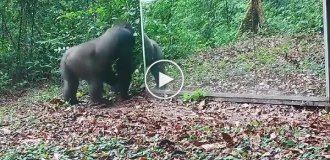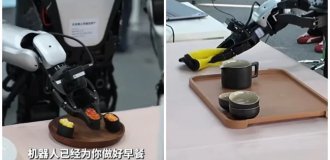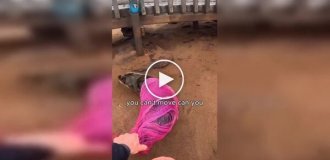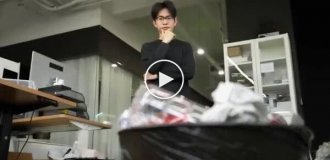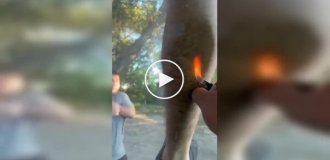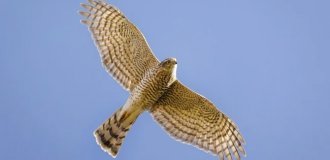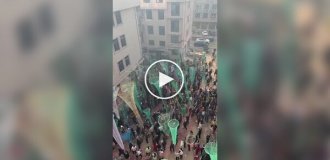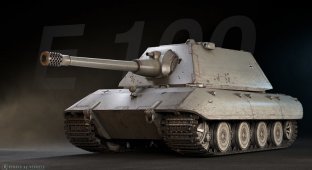For a number of reasons, heavy tanks were not particularly popular in the Soviet Union. Despite the good combat qualities of the KV and IS series tanks, the most famous domestic armored vehicle is the medium T-34. One can talk for a long time about the prerequisites for such a situation, but the fact remains a fact.
Moreover, some Soviet-designed heavy tanks not only failed to become the most famous representatives of their class, but even to receive at least some fame.

In the summer of 1943, N.L. was appointed chief designer of SKB-2 at the Chelyabinsk Kirov Plant (ChKZ). Spirits. Having enough information about the state of German tank building and the prospects for its development, Dukhov immediately began to promote the idea of creating a new heavy tank. In his opinion, the Red Army needed a machine that would not be inferior in protection and armament to the German Tigers. In addition, it was necessary to ensure that the tank was protected from all existing and future anti-tank weapons. In general, the project was not going to be easy, and some problems arose with the promotion of the idea. As a result, the management of ChKZ decided to develop a new project under the letter “K” on its own initiative.
As was the case during the Great Patriotic War, the design did not take much time. Already in December of the same 43rd year, a preliminary design was ready. The general layout of the Project K tank was borrowed from the IS-122. The remaining components and assemblies were either changed or seriously modified. Thus, the protection was strengthened by increasing the thickness of the armor plates. The thickening of the armor entailed an increase in mass. This problem was solved by increasing the number of road wheels to seven per side. For the same reasons, it was necessary to increase the width of the tracks to 730 mm. Finally, the heavier turret received a new system of attachment to the hull and rotation. All with the same goal - to ensure the normal functioning of large mass units.
The first prototype of the IS-4 tank: "object 701-2"

However, increasing the number of road wheels and updating the turret support could not by itself provide sufficient driving characteristics. A new engine was needed. Just at this time, SKB-75 completed work on the V-12 diesel engine. The V-twin engine with 12 cylinders was made on the basis of the earlier V-2 and, thanks to a new supercharger, modified fuel supply, and a number of other innovations, had a power of 750 horsepower. It is noteworthy that the radiators were equipped with fans that blew and cooled them. This system was borrowed from German heavy tanks.

After finishing work on the preliminary design, the K tank was renamed Object 701. By this time, ChKZ engineers together with Moscow Higher Technical School named after. Bauman completed a new transmission system for the Object 701, the rotation mechanism of which was based on the so-called. "Group of Zaichik-Kreines mechanisms." This transmission system was created back in the mid-thirties, but then, for a number of reasons, it could not be used on anything other than experimental machines. In the case of the new heavy tank, the use of this system was more than justified. Given the available capabilities, the specific power of the tank could not be raised above 12-15 hp/t. In such conditions, the turning mechanism of the “ZK” system made it possible to significantly reduce the engine power required for turning, which ultimately affected most of the driving characteristics.
When the transmission project was ready, SKB-2 engineers completed design work on the entire “Object 701” as a whole. The hull armor plates had a thickness of 120 to 160 millimeters and were made of 42CM grade steel. The tower with a maximum thickness of 250 mm (front) was cast from 66L steel. The main hull plates and turret were processed to medium hardness. Smaller parts of the body were cast and stamped from grade 8C steel and machined to high hardness. An interesting fact is that most of the large-sized parts of the body were connected not only by welding, but also using relief pins. In combination with the new shape of the gussets, this made it possible to change the type of load on the welds: on the IS-122 they worked for shear, on the Object 701 - for compression.

The finished project of the Object 701 tank was ready at the very beginning of the spring of 1944. Then, in March, he was introduced to the Main Armored Directorate of the Red Army. The GABTU commission assessed the project and recommended building two prototypes as soon as possible. The Office concluded that the Object 701 could soon become the best heavy tank in the world. At the beginning of April 1944, the State Defense Committee issued a decree requiring the Chelyabinsk plant to produce two tanks and one hull within the month of April. The latter was needed for test firing, and the tanks were intended for running and fire tests. As the “main caliber” for the new armored vehicles, the State Defense Committee proposed a new weapon created in the Central Artillery Design Bureau of the People's Commissariat of Armaments.
The second prototype of the IS-4 tank: "object 701-5"

It’s worth taking a closer look at this weapon. In the first months of 1944, the TsAKB NKV quickly created a new 100-mm S-34 gun, which had a barrel length of 56 calibers and the ballistics of a B-34 gun. At the same time, artillery designers created the S-34-II cannon with a caliber of 122 mm, a barrel length of 47 calibers and the ballistics of an A-19 gun. It was the 122-mm version of the new gun that was proposed for installation on the Object 701. However, the dimensions of the breech of the S-34-II gun did not allow it to fit into the existing fighting compartment. Therefore, the designers of TsAKB and SKB-2 had to urgently modify both the gun and the tank’s turret. Because of this, the initial monthly period allocated for the construction of prototypes, in practice, shifted slightly and the assembly of tank No. 1 began only in May.
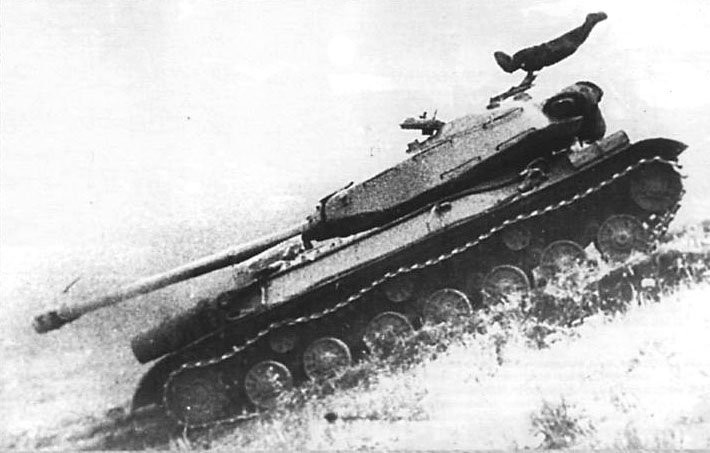
A little earlier, back in April, tank No. 0 was manufactured. This strange designation of the first experimental vehicle was caused by the fact that the first tank of the Object 701 project did not fully meet the original technical requirements. Therefore, they decided to use the “zero” tank as a platform for testing new ideas, but not consider it an experimental vehicle of the “701” project. Until mid-June 1944, tank No. 0 had covered more than 1,200 kilometers and helped discover a number of design flaws that were urgently corrected. Thanks to the tests of tank No. 0, it was possible to significantly improve the next vehicle of the 701 project. Tanks No. 1 and No. 2 were assembled around the time that "Number Zero" completed its tests. During the production of the first and second experimental vehicles, a new proposal was received: to equip one experimental tank with a 122 mm cannon, and the other with a 100 mm gun. And so they did. No. 1 received the S-34-II gun, and No. 2 was armed with the S-34.
On July 1, 1944, testing of tanks No. 1 and No. 2 began at a training ground near Chelyabinsk. At first they were relatively successful - the running-in of tank No. 0 had an effect. However, tank No. 1 did not have time to travel around the training ground for two weeks before it had to be sent for repairs. During the next trip, the final drives on it broke. Combined with regular minor problems with other transmission components, this required stopping testing of tank No. 1. In 13 days at the test site, he managed to travel about 1,100 kilometers at an average speed of 21 km/h. Tank No. 2, in turn, suffered no breakdowns and was tested until they were completed on August 15. However, he also had problems. Everything was fine with the transmission, but the cooling system let us down: the radiators and fans could not cope with their duties and most of the time the diesel engine of tank No. 2 operated at elevated temperatures. In such conditions, the second tank covered almost 500 kilometers at an average speed of about 25 km/h. On the second tank, in addition, it was possible to measure fuel consumption. By modern standards, it was simply colossal - 97-102 liters per 100 kilometers.
Rear view of the IS-4 tank. Noteworthy is the arrangement of cylindrical external fuel tanks, which is characteristic and unusual for Soviet tanks.

Despite the identified shortcomings of both tanks and breakdown No. 1, the GABTU commission recognized the design as successful:
The experimental tank 701, in its basic combat qualities, is the most modern heavy tank, superior in armor to all existing domestic tanks, and, in addition, to enemy tanks in armament and maneuverability.
There is an opinion that it was the good armor, which no German gun could penetrate at most distances, that became the reason for the commission to turn a blind eye to the mass of shortcomings in the design of the Object 701. At the same time, “childhood diseases” are characteristic of any tanks and representatives of any other classes of equipment. For this reason, the GABTU issued a document to the SKB-2 designers with requirements for finalizing the new tank. It was necessary to improve visibility through the driver's optics, facilitate access to the engine and transmission compartment and strengthen the front road wheels.

Immediately after the completion of the field tests, test firing began. It is interesting that before the shooting began, tanks No. 0 and No. 1 swapped turrets. This was done due to a serious breakdown of the “First Number”. Thus, No. 0 went to the Gorokhovetsky training ground with the 122-mm S-34-II gun. Until October 2, 780 rounds were fired under the test program. Based on the test firing results, it was found that the S-34-II gun has better accuracy and accuracy characteristics compared to the D-25T gun. The reason for the victory of the S-34-II was the new, more rigid design of the gun mounts to the recoil devices and to the tank structure. In addition, the S-34-II, unlike the D-25T, did not have a muzzle brake. Firstly, this exposed the tank less when firing, and secondly, the infantry walking next to the tank had less risk of injury.
Placement of ammunition in the tank:
1,3,5,7,10 - sleeve stacks,
2,4,9,4 - magazine boxes, 6,12 - shell stowage, 8 - cartridge bags.

Cassette:
1 — shock-absorbing spring, 2 — cylinder, 3 — spring lock, 4 — glass, 5 — safety cap.

Tank No. 2 and the armored hull (designated "3") were much less fortunate at the end of sea trials - they were used as targets at the Kubinka training ground. The hulls of the second and third copies were “mocked” using a whole set of different guns: from Soviet ZiS-2 and D-25 to captured German PaK 43 and KwK 42. The strength test report stated the following:
The armor of the "object 701" tank provides complete protection from 75- and 88-mm armor-piercing shells with an initial projectile speed of 1000 m/s from all distances with directional fire up to ±60° along the hull and ±30° along the turret.
At the same time, at high angles of fire, the strength of the hull and turret was considered insufficient. Also, criticism was caused by the turret extension intended for mounting the sight - it significantly reduced the protection of its frontal part.
Control department of the IS-4 tank:
1 - cartridges with charge, 2 - batteries, 3 - fuel distribution valve, 4 - manual fuel pump, 5 - control pedal, 6 - driver's seat, 7 - fuel pedal, B - manual fuel supply sector, 9 - rocker, Yu - ground switch, II - turret stopper, 12 - automatic PPO valve, 13 - panel light, 14 - PPO panel and 1ADSh, 14 - relay regulator, 16 - speedometer, 17 - air intake instrument panel, 1B - tank for draining fuel when air is released, 19 - carbon dioxide cylinder, 20 - driver's observation devices, 21 - driver's instrument panel, 22 - compressed air cylinders, 23 - control roar. 24 — tachometer, 25 — electrical instrument panel, 26 — emergency lamp, 27 — electrical signal.

And again, the commission of the People's Commissariat of the Tank Industry presented its requirements for modifying the tank. After this, according to the commission, the hull and turret of tank No. 2 could be recommended for production. On August 11, 44th, People's Commissar of Tank Industry V.A. Malyshev signed an order in which the SKB-2 designers were required to correct all the shortcomings and present two modified tanks for testing by October.
In the course of correcting the identified deficiencies, Chelyabinsk designers not only improved protection and updated a number of units, but also prepared a version of the project with a new transmission. Autumn tests of two new prototypes passed almost without problems, at least less than in summer. Another document was released, in which the Object 701 tank was recommended for adoption and mass production. However, this only concerned the design, engine, transmission, etc. There was no such confidence about the gun in the fall of 1944. On the one hand, the S-34-II gun had good accuracy. On the other hand, the D-25T was already in production. At the very end of 1944, comparative tests of both guns were once again carried out, based on the results of which the country’s military leadership decided to equip the “701” tank with D-25T guns. The entire range of characteristics of the new tank, in particular the level of protection, made it possible to use a weapon on it with slightly less accuracy, but already in production without any significant loss in combat qualities.
IS-4M

In April 1945, the new tank was finally put into service under the name IS-4. Compared to the 701 tank from the fall of 1944, it had a number of changes, mainly related to production technology. In addition to the cannon, the IS-4 tank received coaxial and anti-aircraft 12.7-mm DShK machine guns. The tank had a crew of four people.
IS-4 in the museum in Kubinka

Video: IS-4 tank on the move in Kubinka
Obviously, the IS-4 did not physically have time to take part in the Great Patriotic War. After the victory over Germany and then Japan, the production of new heavy tanks was frozen for some time in favor of the IS-3. In addition, most bridges in the Soviet Union simply could not support a vehicle with a combat weight of almost 60 tons. However, upon completion of serial production of the IS-3 tanks, they returned to the former “Object 701”. Already in 1947, production of the IS-4 was resumed, slightly changing the composition of the equipment. Before production ended in 1949, 244 cars were assembled. With excellent weapons and protection indicators for the mid-forties at the end of the decade, the IS-4 could no longer count on great prospects. The combat weight, which increased to 60 tons, did not add to optimism. Therefore, in the early 50s, IS-4 tanks began to be taken out of service, and then they were completely removed from service. Some of the tanks went into storage, and some went to work as targets at training grounds. Only a few copies of the heaviest Soviet tank, mass-produced, have survived to this day: in the museums of Kubinka and Chita, in Zabaikalsk (monument), as well as on the border with China, where several IS-4 turrets have been preserved, installed as stationary firing points.

IS-4s dug out of the ground, previously installed on the Soviet-Chinese border as firing points.
After the events of 1969 near Lake Zhalanashkol, the tanks were buried, and the tanks were recently excavated. And they became unique monuments to Soviet-Chinese “friendship.”



In its complete state, the IS-4 tank can be seen only in two places: in Kubinka near Moscow in the exhibition of the Museum of Armored Weapons and Equipment and as a monument in the village of Zabaikalsk, Chita region.

